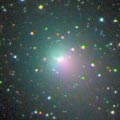
|
Now it is so bright as 8.2 mag (Aug. 21, Juan Jose Gonzalez). It will be observable at 8-10 mag in good condition for a long time until late autumn.
Date(TT) R.A. (2000) Decl. Delta r Elong. m1 Best Time(A, h)
Aug. 22 20 7.76 18 57.6 2.334 3.158 137 8.1 22:03 ( 0, 74)
Aug. 29 19 54.33 15 25.1 2.381 3.169 134 8.1 21:22 ( 0, 70)
|
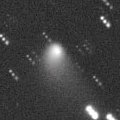
|
It brightened up to 9.8 mag on June 13 (Marco Goiato). Now it is not observable. But it keeps as bright as 10-11 mag for a long time untio 2010 spring. In the Northern Hemisphere, it will appear in the morning sky in early October, then it keeps observable at 10 mag in good condition for a long time. In the Southern Hemisphere, it will locate extremely low only after this.
Date(TT) R.A. (2000) Decl. Delta r Elong. m1 Best Time(A, h)
Aug. 22 9 32.85 3 24.0 3.296 2.313 11 9.8 3:54 (253,-18)
Aug. 29 9 46.02 4 5.1 3.274 2.296 12 9.7 4:01 (256,-13)
|
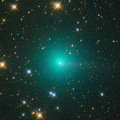
|
It brightened up to 6.7 mag in June (June 9, Marco Goiato). Now it is fading, but still bright as 9.5 mag (Aug. 21, Juan Jose Gonzalez). However, it will be unobservable soon. It will appear in the morning sky again at 13 mag in November. It may be visible visually again.
Date(TT) R.A. (2000) Decl. Delta r Elong. m1 Best Time(A, h)
Aug. 22 12 44.28 2 12.1 2.604 1.953 40 10.1 20:10 ( 87, 8)
Aug. 29 12 47.68 3 16.1 2.734 1.989 34 10.4 19:59 ( 90, 6)
|
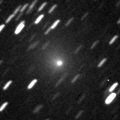
|
It brightened up to 8.5 mag in May and June (May 26, Juan Jose Gonzalez). Now it is fading, but still bright as 10.7 mag (Aug. 22, Marco Goiato). It will never be observable again in the Northern Hemisphere. In the Southern Hemisphere, it keeps observable for a long time after this in the evening sky.
Date(TT) R.A. (2000) Decl. Delta r Elong. m1 Best Time(A, h)
Aug. 22 11 2.39 -40 52.7 1.967 1.605 54 10.1 20:10 ( 60,-34)
Aug. 29 11 30.47 -44 16.2 2.026 1.674 55 10.4 19:59 ( 56,-33)
|
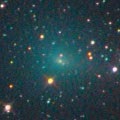
|
It brightened up to 8.8 mag in May and June (May 19, Juan Jose Gonzalez). Now it is still bright as 10.4 mag (Aug. 21, Juan Jose Gonzalez). It will be bright at 9-10 mag for a long time until autumn.
Date(TT) R.A. (2000) Decl. Delta r Elong. m1 Best Time(A, h)
Aug. 22 22 52.83 -13 21.5 0.802 1.804 168 10.2 0:53 ( 0, 42)
Aug. 29 22 48.72 -14 12.2 0.830 1.837 173 10.4 0:21 ( 0, 41)
|
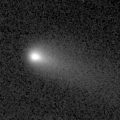
|
It is already so bright as 10.1 mag (Aug. 19, Juan Jose Gonzalez). It will be observable at 10-11 mag in a good condition for a long time from summer to winter.
Date(TT) R.A. (2000) Decl. Delta r Elong. m1 Best Time(A, h)
Aug. 22 3 29.58 -3 3.5 0.585 1.246 99 11.2 3:54 (325, 46)
Aug. 29 3 59.31 -3 16.5 0.578 1.232 98 11.0 4:01 (327, 46)
|
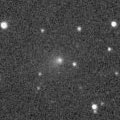
|
It is so bright as 9.8 mag visually (Aug. 21, Juan Jose Gonzalez), much brighter than this ephemeris. It keeps observable for a long time until 2010 February. It will keep 10 mag until the end of 2009. But in the Northern Hemisphere, it keeps very low after this. It locates a bit higher in the Southern Hemisphere.
Date(TT) R.A. (2000) Decl. Delta r Elong. m1 Best Time(A, h)
Aug. 22 14 12.13 -14 41.1 1.542 1.475 66 11.8 20:10 ( 60, 14)
Aug. 29 14 30.11 -16 28.1 1.553 1.448 64 11.5 19:59 ( 58, 13)
|

|
It must have reached up to 11 mag in summer. However, the condition of this apparition is worst. We can not observe it at all.
Date(TT) R.A. (2000) Decl. Delta r Elong. m1 Best Time(A, h)
Aug. 22 10 13.47 17 26.8 2.226 1.225 6 11.7 20:10 (122,-12)
Aug. 29 10 39.69 15 14.3 2.239 1.240 6 12.0 19:59 (118,-12)
|
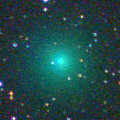
|
It was bright as 8-9 mag in April and May. Although it had been unobservable for a while, now it is appearing in the morning sky. It should be bright as 12 mag still now. It will be fading slowly in the low sky after this. In the Southern Hemisphere, it keeps observable in good condition for a long time.
Date(TT) R.A. (2000) Decl. Delta r Elong. m1 Best Time(A, h)
Aug. 22 7 44.41 3 43.8 2.737 2.002 35 11.7 3:54 (268, 4)
Aug. 29 7 50.48 0 48.9 2.735 2.075 40 11.9 4:01 (275, 9)
|
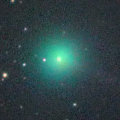
|
It has been observed bright as 8-9 mag from April to June. Now it is fading. It was still bright as 11.0 mag in July (July 12, Marco Goiato). However, no observations have been reported since August. So it may have faded out rapidly. In the Southern Hemisphere, it keeps observable in a good condition for a long time. In the Northern Hemisphere, it will never be observable again.
Date(TT) R.A. (2000) Decl. Delta r Elong. m1 Best Time(A, h)
Aug. 22 9 55.69 -50 41.6 2.485 2.210 62 12.9 3:54 (310,-45)
Aug. 29 10 6.14 -50 31.4 2.618 2.290 60 13.2 4:01 (310,-41)
|

|
It brightened up to 11 mag in spring and summer. Now it is not observable. It will appear in the morning sky at 15 mag in early 2010. But it locates somewhat low in the Northern Hemisphere.
Date(TT) R.A. (2000) Decl. Delta r Elong. m1 Best Time(A, h)
Aug. 22 12 34.01 -3 58.3 2.857 2.188 40 13.2 20:10 ( 84, 2)
Aug. 29 12 47.49 -5 31.4 2.909 2.194 37 13.3 19:59 ( 83, 0)
|
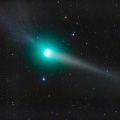
|
It passed near by the earth in late February, and it reached up to 4.9 mag (Feb. 23, Juan Jose Gonzalez). It had been unobservable for a while, but it is appearing in the morning sky again. Now it is 14.9 mag (Aug. 14, Ken-ichi Kadota). In the Northern Hemisphere, it is observable at 15 mag in good condition from autumn to winter. It may be visible visually.
Date(TT) R.A. (2000) Decl. Delta r Elong. m1 Best Time(A, h)
Aug. 22 7 18.99 21 0.5 3.966 3.264 40 14.1 3:54 (257, 19)
Aug. 29 7 19.80 20 56.2 3.944 3.339 47 14.2 4:01 (262, 26)
|

|
Now it is not observable. It will appear in the morning sky in September.
Date(TT) R.A. (2000) Decl. Delta r Elong. m1 Best Time(A, h)
Aug. 22 9 4.89 16 54.5 7.125 6.155 15 14.2 3:54 (246, -4)
Aug. 29 9 9.96 16 28.5 7.091 6.156 20 14.2 4:01 (251, 1)
|
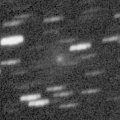
|
Appearing in the morning sky. Now it is 12.8 mag and visible visually (July 25, Juan Jose Gonzalez). It will be getting higher gradually while fading slowly after this.
Date(TT) R.A. (2000) Decl. Delta r Elong. m1 Best Time(A, h)
Aug. 22 7 28.49 25 31.9 2.254 1.602 39 14.3 3:54 (252, 20)
Aug. 29 7 47.64 24 30.2 2.260 1.644 41 14.5 4:01 (255, 22)
|
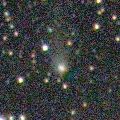
|
It brightened up to 11.5 mag in last summer (Aug. 4, Marco Goiato). Now it is 15.9 mag (Aug. 12, H. Sato). It keeps observable in good condition for a long time in the Southern Hemisphere. It will be observable again also in the Northern Hemisphere after September. It will keep 15-16 mag until next spring.
Date(TT) R.A. (2000) Decl. Delta r Elong. m1 Best Time(A, h)
Aug. 22 6 33.88 -37 32.6 4.111 3.878 69 14.5 3:54 (311, -7)
Aug. 29 6 36.63 -37 53.5 4.119 3.927 72 14.5 4:01 (316, -3)
|

|
It brightened up to 9.8 mag in winter (Dec. 28, Juan Jose Gonzalez). It faded down to 12.5 mag in May (May 26, Juan Jose Gonzalez), and became unobservable. Now it is not observable, however, it will be observable in good condition again in winter at 15 mag. Then it may be still visible visually.
Date(TT) R.A. (2000) Decl. Delta r Elong. m1 Best Time(A, h)
Aug. 22 9 26.54 16 1.8 5.271 4.279 10 14.5 3:54 (244, -8)
Aug. 29 9 33.21 15 8.9 5.301 4.333 14 14.6 4:01 (249, -4)
|

|
It was observed as bright as 13 mag in spring and summer. It will be too low to observe soon. It will brighten up to 12-13 mag in 2010 summer.
Date(TT) R.A. (2000) Decl. Delta r Elong. m1 Best Time(A, h)
Aug. 22 13 7.53 -1 41.4 3.281 2.702 47 14.6 20:10 ( 81, 10)
Aug. 29 13 17.16 -3 0.3 3.327 2.685 43 14.6 19:59 ( 81, 8)
|
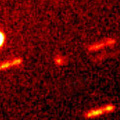
|
Now it is 15.9 mag (Aug. 29, H. Sato). It will be getting higher after this. It will be observable bright as 9-10 mag in a good condition for a long time from winter to spring. It keeps observable until 2010 autumn when it fades down to 16 mag.
Date(TT) R.A. (2000) Decl. Delta r Elong. m1 Best Time(A, h)
Aug. 22 7 23.28 20 21.0 3.026 2.335 39 14.9 3:54 (257, 18)
Aug. 29 7 37.76 19 52.0 2.930 2.294 42 14.7 4:01 (260, 22)
|

|
First return of a new bright periodic comet. It was observed as an asteroid in June. Now it is 17.3 mag by CCD observations (Aug. 3, Siding Spring Survey). However, because it looks very diffuse, the total magnitude can be around 14-15 mag. The condition in this apparition is very good. The comet will pass near by the earth and is expected to reach up to 13-14 mag. It is not observable in latter half of August temporarily. In the Northern Hemisphere, it appears in the morning sky at 15 mag in late August, then it keeps observable in a good condition. Maybe it becomes visible visually.
Date(TT) R.A. (2000) Decl. Delta r Elong. m1 Best Time(A, h)
Aug. 22 8 43.34 8 3.6 0.232 0.798 20 14.8 3:54 (257, -5)
Aug. 29 8 19.85 14 32.8 0.287 0.782 32 15.2 4:01 (259, 10)
|
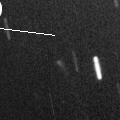
|
Now it is 14.5 mag (July 30, H. Sato). It keeps observable in good condition at 15 mag until late autumn.
Date(TT) R.A. (2000) Decl. Delta r Elong. m1 Best Time(A, h)
Aug. 22 0 30.52 24 14.4 3.186 3.905 129 14.9 2:30 ( 0, 79)
Aug. 29 0 23.81 25 34.3 3.126 3.910 135 14.9 1:56 ( 0, 81)
|

|
Now it is 15.2 mag (Aug. 3, H. Sato). It passes the perihelion in September, and now it is brightest. It keeps observable in good condition in the Southern Hemisphere. It is not observable now in the Northern Hemisphere. But it will appear in the evening sky at the end of September, and then it will be getting higher while fading.
Date(TT) R.A. (2000) Decl. Delta r Elong. m1 Best Time(A, h)
Aug. 22 13 54.65 -56 3.0 0.836 1.231 82 15.1 20:10 ( 31,-16)
Aug. 29 14 40.09 -56 20.5 0.806 1.217 83 15.0 19:59 ( 28,-13)
|
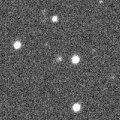
|
Now it is 15.3 mag (Aug. 22, H. Sato). It keeps 15 mag until 2010, and will be observable for a long time in good condition.
Date(TT) R.A. (2000) Decl. Delta r Elong. m1 Best Time(A, h)
Aug. 22 16 0.56 47 24.5 2.787 2.807 80 15.2 20:10 (126, 62)
Aug. 29 15 50.24 44 30.4 2.859 2.799 76 15.3 19:59 (119, 58)
|
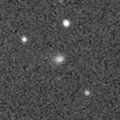
|
It has brightened up to 14 mag in outburst in 2008 August. Now it is bright as 14.3 mag (July 13, H. Sato), brighter than originally expected.
Date(TT) R.A. (2000) Decl. Delta r Elong. m1 Best Time(A, h)
Aug. 22 21 2.09 -41 49.2 2.187 3.086 147 15.4 22:58 ( 0, 13)
Aug. 29 20 58.73 -42 11.3 2.246 3.101 141 15.5 22:27 ( 0, 13)
|

|
Now it is 14.9 mag (Aug. 26, H. Sato). It keeps 15 mag until winter. It keeps observable in a good condition in the Southern Hemisphere. But in the Northern Hemisphere, it will be getting lower gradually, and it is only observable until late autumn.
Date(TT) R.A. (2000) Decl. Delta r Elong. m1 Best Time(A, h)
Aug. 22 0 21.48 -1 48.8 2.040 2.923 144 15.7 2:21 ( 0, 53)
Aug. 29 0 14.87 -5 39.3 1.949 2.889 153 15.6 1:47 ( 0, 50)
|

|
It brightened up to 13 mag from 2007 to 2009, and it was observed visually for a long time. It will fade out gradually after this. But it keeps 16 mag until 2010 spring, and 17 mag until 2010 autumn. Although it becomes low in autumn temporarily, it keeps observable in good condition from winter to summer.
Date(TT) R.A. (2000) Decl. Delta r Elong. m1 Best Time(A, h)
Aug. 22 13 4.63 32 22.7 7.632 6.969 46 15.7 20:10 (112, 27)
Aug. 29 13 5.55 31 55.5 7.710 6.998 42 15.8 19:59 (113, 24)
|
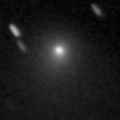
|
It reached to 10.9 mag in 2008 spring (May 11, Marco Goiato). It is fading slowly, but still bright as 15.0 mag (Aug. 20, H. Sato). Although it becomes low in winter temporarily, it keeps observable for a long time until 2010 spring when it becomes fainter than 18 mag.
Date(TT) R.A. (2000) Decl. Delta r Elong. m1 Best Time(A, h)
Aug. 22 16 8.80 32 27.1 4.864 4.874 84 15.7 20:10 ( 93, 64)
Aug. 29 16 11.86 31 40.7 4.976 4.925 81 15.8 19:59 ( 93, 61)
|
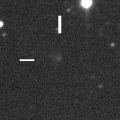
|
Now it is 16.2 mag (Aug. 13, Ken-ichi Kadota), brightening as expected. It will reach up to 12 mag in 2012, and will be observable visually at 12-13 mag for a long time from 2011 to 2013. In 2009, it is observable in good condition at 16 mag from summer to autumn. In the Northern Hemisphere, the comet will be low around its brightest seasons.
Date(TT) R.A. (2000) Decl. Delta r Elong. m1 Best Time(A, h)
Aug. 22 22 22.95 4 41.4 7.664 8.636 162 15.8 0:23 ( 0, 60)
Aug. 29 22 18.31 4 18.1 7.616 8.599 165 15.8 23:46 ( 0, 59)
|
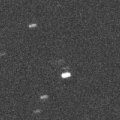
|
New periodic comet. It has already passed the perihelion in late June. But unexpectedly, it keeps unusual brightening very rapidly after that. Now it became bright as 15.0 mag (July 30, D. Chestnov). It keeps observable in the evening low sky for a while after this. But it may fade out very rapidly.
Date(TT) R.A. (2000) Decl. Delta r Elong. m1 Best Time(A, h)
Aug. 22 13 49.53 -6 17.8 1.728 1.484 58 15.8 20:10 ( 70, 16)
Aug. 29 14 12.02 -8 16.8 1.791 1.522 58 16.0 19:59 ( 68, 16)
|
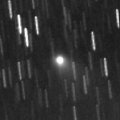
|
It reached up to 12.6 mag and became visible visually in June and July (June 25, Katsumi Yoshimoto). However, it is fading rapidly after August. It has already faded down to 16.8 mag (Aug. 16, Ken-ichi Kadota). It will be fainter than 18 mag in October.
Date(TT) R.A. (2000) Decl. Delta r Elong. m1 Best Time(A, h)
Aug. 22 18 54.72 3 45.1 0.827 1.671 130 15.8 20:52 ( 0, 59)
Aug. 29 19 2.44 3 15.9 0.911 1.718 126 16.1 20:32 ( 0, 58)
|

|
Now it is 16.0 mag (Aug. 16, Francois Kugel). It will brighten rapidly after this. It will reach to 12 mag and become visible visually in winter. In the Northern Hemisphere, it keeps observable in good condition for a long time after this until 2010 spring when it fades out.
Date(TT) R.A. (2000) Decl. Delta r Elong. m1 Best Time(A, h)
Aug. 22 4 33.48 13 36.7 2.176 2.239 80 16.2 3:54 (291, 49)
Aug. 29 4 45.43 13 36.0 2.079 2.215 84 16.0 4:01 (297, 53)
|

|
Appearing in the morning sky. It has not been recovered yet. But it must have already brightened up to 16.5 mag. It will be getting higher rapidly after this, and will be observable in good condition at 16 mag in autumn.
Date(TT) R.A. (2000) Decl. Delta r Elong. m1 Best Time(A, h)
Aug. 22 5 49.19 29 26.4 2.279 2.003 61 16.4 3:54 (259, 41)
Aug. 29 6 2.57 31 29.3 2.222 2.021 65 16.3 4:01 (259, 46)
|
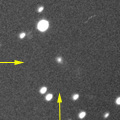
|
Now it is 16.6 mag (Aug. 23, Ken-ichi Kadota). It will reach to 15 mag in 2010. It keeps observable for a long time after this in the Northern Hemisphere.
Date(TT) R.A. (2000) Decl. Delta r Elong. m1 Best Time(A, h)
Aug. 22 15 9.12 8 3.5 5.711 5.535 74 16.7 20:10 ( 69, 40)
Aug. 29 15 11.79 7 57.8 5.775 5.504 69 16.7 19:59 ( 71, 37)
|
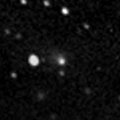
|
It brightened up to 15-16 mag in 2008 summer. It keeps observable at 17 mag in good condition for a long time until winter. It was observed as 18 mag recently, a bit fainter than this ephemeris.
Date(TT) R.A. (2000) Decl. Delta r Elong. m1 Best Time(A, h)
Aug. 22 3 42.07 29 26.1 2.870 3.025 88 17.0 3:54 (276, 67)
Aug. 29 3 47.08 30 16.4 2.792 3.040 94 17.0 4:01 (281, 73)
|
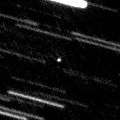
|
It passed the perihelion in June, but it was not observable, too close to the sun. Although it was predicted to be 13.5 mag, the STEREO spacecraft revealed that it brightened up to 10-11 mag, much brighter than expected. Now it is 16.4 mag (Aug. 23, C00). It keeps observable at 16-17 mag until late autumn.
Date(TT) R.A. (2000) Decl. Delta r Elong. m1 Best Time(A, h)
Aug. 22 4 35.84 45 12.2 1.169 1.350 76 17.1 3:54 (239, 58)
Aug. 29 4 30.91 46 36.7 1.151 1.436 82 17.1 4:01 (234, 64)
|
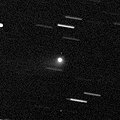
|
It reached up to 14 mag in 2008 autumn. It is still bright as 16.0 mag (July 30, H. Sato). It keeps observable around 17 mag in a good condition for a while.
Date(TT) R.A. (2000) Decl. Delta r Elong. m1 Best Time(A, h)
Aug. 22 22 33.97 18 36.1 3.903 4.796 148 17.3 0:34 ( 0, 74)
Aug. 29 22 23.26 17 46.4 3.919 4.839 152 17.4 23:51 ( 0, 73)
|
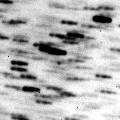
|
Now it is 17.4 mag (Aug. 20, Catalina Sky Survey). The condition is good in this apparition. It will approach to the earth down to 0.38 A.U., and will be observable in good condition at 16.5 mag in November. It keeps observable until that time after this. But it locates somewhat low in the Northern Hemisphere.
Date(TT) R.A. (2000) Decl. Delta r Elong. m1 Best Time(A, h)
Aug. 22 16 12.02 -18 47.3 0.682 1.274 95 17.6 20:10 ( 33, 29)
Aug. 29 16 20.85 -18 46.5 0.672 1.222 90 17.6 19:59 ( 35, 28)
|
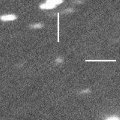
|
It keeps observable at 17 mag for a long time from 2010 to 2012. Now it is 18.5 mag (Aug. 25, W. Hasubick), a bit fainter than this ephemeris.
Date(TT) R.A. (2000) Decl. Delta r Elong. m1 Best Time(A, h)
Aug. 22 3 46.13 20 41.0 8.874 8.931 89 17.7 3:54 (293, 62)
Aug. 29 3 44.44 20 42.8 8.732 8.913 97 17.7 4:01 (306, 68)
|

|
Now it is 17.3 mag (Aug. 23, Ken-ichi Kadota). It keeps observable at 17-18 mag for a long time until 2011.
Date(TT) R.A. (2000) Decl. Delta r Elong. m1 Best Time(A, h)
Aug. 22 4 31.03 65 7.3 5.356 5.213 76 17.8 3:54 (206, 52)
Aug. 29 4 33.25 66 48.3 5.255 5.193 81 17.8 4:01 (200, 54)
|
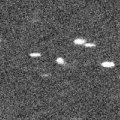
|
Now it is 17.5 mag (Aug. 14, Michael Jager). It will be getting lower in the evening sky after this. But it will be observable at 17 mag from spring to summer in 2010.
Date(TT) R.A. (2000) Decl. Delta r Elong. m1 Best Time(A, h)
Aug. 22 16 7.53 40 59.7 3.603 3.620 82 17.9 20:10 (113, 65)
Aug. 29 16 12.28 38 37.6 3.613 3.591 80 17.8 19:59 (107, 62)
|
|
![]()
 C/2009 F6 ( Yi-SWAN )
C/2009 F6 ( Yi-SWAN ) C/2009 G1 ( STEREO )
C/2009 G1 ( STEREO ) 116P/Wild 4
116P/Wild 4 C/2007 N3 ( Lulin )
C/2007 N3 ( Lulin ) 29P/Schwassmann-Wachmann 1
29P/Schwassmann-Wachmann 1 64P/Swift-Gehrels
64P/Swift-Gehrels C/2007 G1 ( LINEAR )
C/2007 G1 ( LINEAR ) C/2006 OF2 ( Broughton )
C/2006 OF2 ( Broughton ) 65P/Gunn
65P/Gunn 81P/Wild 2
81P/Wild 2 222P/2009 MB9 ( LINEAR )
222P/2009 MB9 ( LINEAR ) C/2008 P1 ( Garradd )
C/2008 P1 ( Garradd ) (3552) Don Quixote
(3552) Don Quixote C/2008 N1 ( Holmes )
C/2008 N1 ( Holmes ) 199P/2008 G2 ( Shoemaker 4 )
199P/2008 G2 ( Shoemaker 4 ) C/2009 O4 ( Hill )
C/2009 O4 ( Hill ) C/2005 L3 ( McNaught )
C/2005 L3 ( McNaught ) C/2006 Q1 ( McNaught )
C/2006 Q1 ( McNaught ) C/2006 S3 ( LONEOS )
C/2006 S3 ( LONEOS ) P/2009 K1 ( Gibbs )
P/2009 K1 ( Gibbs ) P/2009 L2 ( Yang-Gao )
P/2009 L2 ( Yang-Gao ) 118P/Shoemaker-Levy 4
118P/Shoemaker-Levy 4 P/2003 A1 ( LINEAR )
P/2003 A1 ( LINEAR ) C/2008 FK75 ( Lemmon-Siding Spring )
C/2008 FK75 ( Lemmon-Siding Spring ) 47P/Ashbrook-Jackson
47P/Ashbrook-Jackson (3200) Phaethon
(3200) Phaethon C/2007 U1 ( LINEAR )
C/2007 U1 ( LINEAR ) 107P/(4015) Wilson-Harrington
107P/(4015) Wilson-Harrington C/2008 S3 ( Boattini )
C/2008 S3 ( Boattini ) C/2007 VO53 ( Spacewatch )
C/2007 VO53 ( Spacewatch ) C/2009 K2 ( Catalina )
C/2009 K2 ( Catalina )![]()































